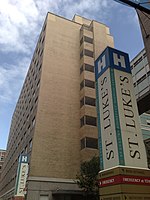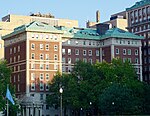Church of Notre Dame (New York City)
1910 establishments in New York City20th-century Roman Catholic church buildings in the United StatesChristian organizations established in 1910Churches on the National Register of Historic Places in New York (state)Morningside Heights, Manhattan ... and 5 more
New York City Designated Landmarks in ManhattanProperties of religious function on the National Register of Historic Places in ManhattanRoman Catholic Archdiocese of New YorkRoman Catholic churches completed in 1910Roman Catholic churches in Manhattan

The Church of Notre Dame is a parish of the Roman Catholic Archdiocese of New York. The church is located at 40 Morningside Drive and the rectory at 405 West 114th Street in Morningside Heights, Manhattan, New York City.
Excerpt from the Wikipedia article Church of Notre Dame (New York City) (License: CC BY-SA 3.0, Authors, Images).Church of Notre Dame (New York City)
West 114th Street, New York Manhattan
Geographical coordinates (GPS) Address Phone number Website External links Nearby Places Show on map
Geographical coordinates (GPS)
| Latitude | Longitude |
|---|---|
| N 40.805 ° | E -73.960555555556 ° |
Address
Church of Notre Dame
West 114th Street 405
10025 New York, Manhattan
New York, United States
Open on Google Maps






